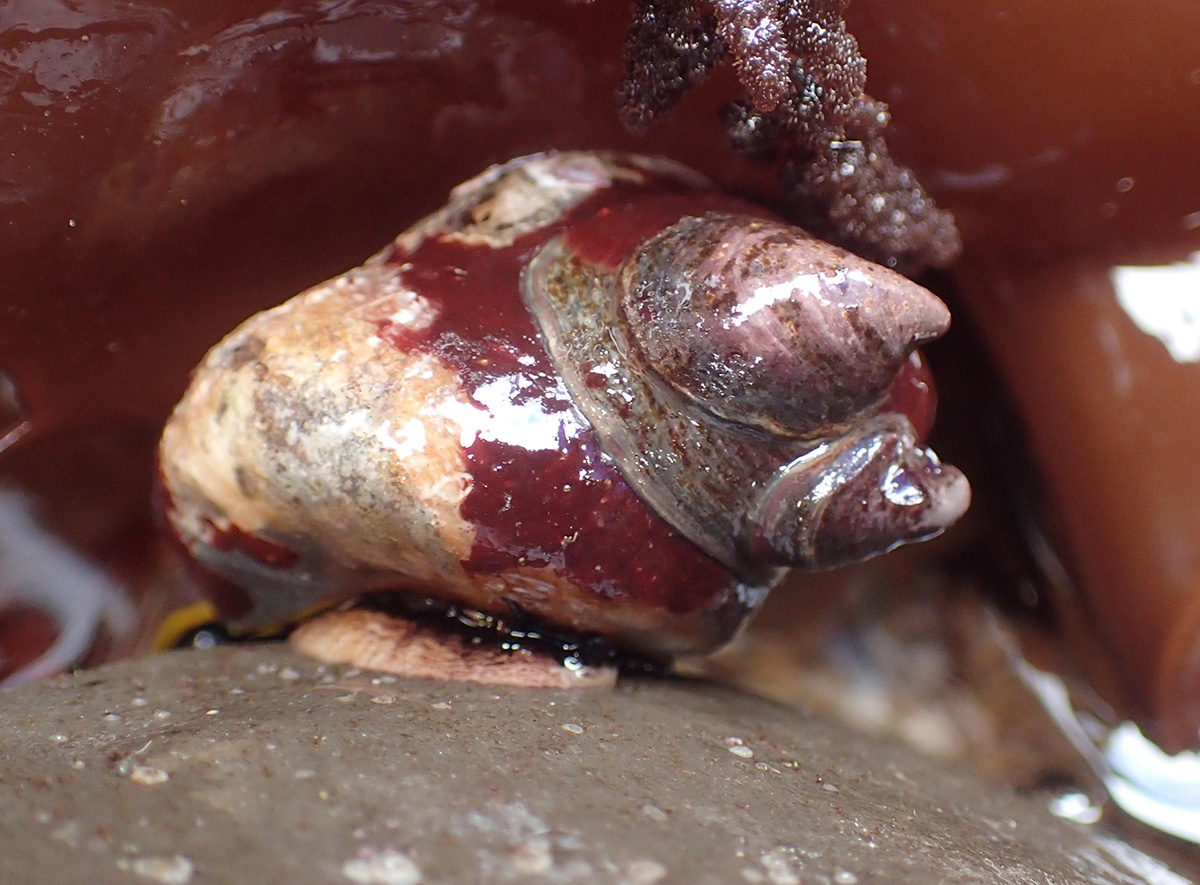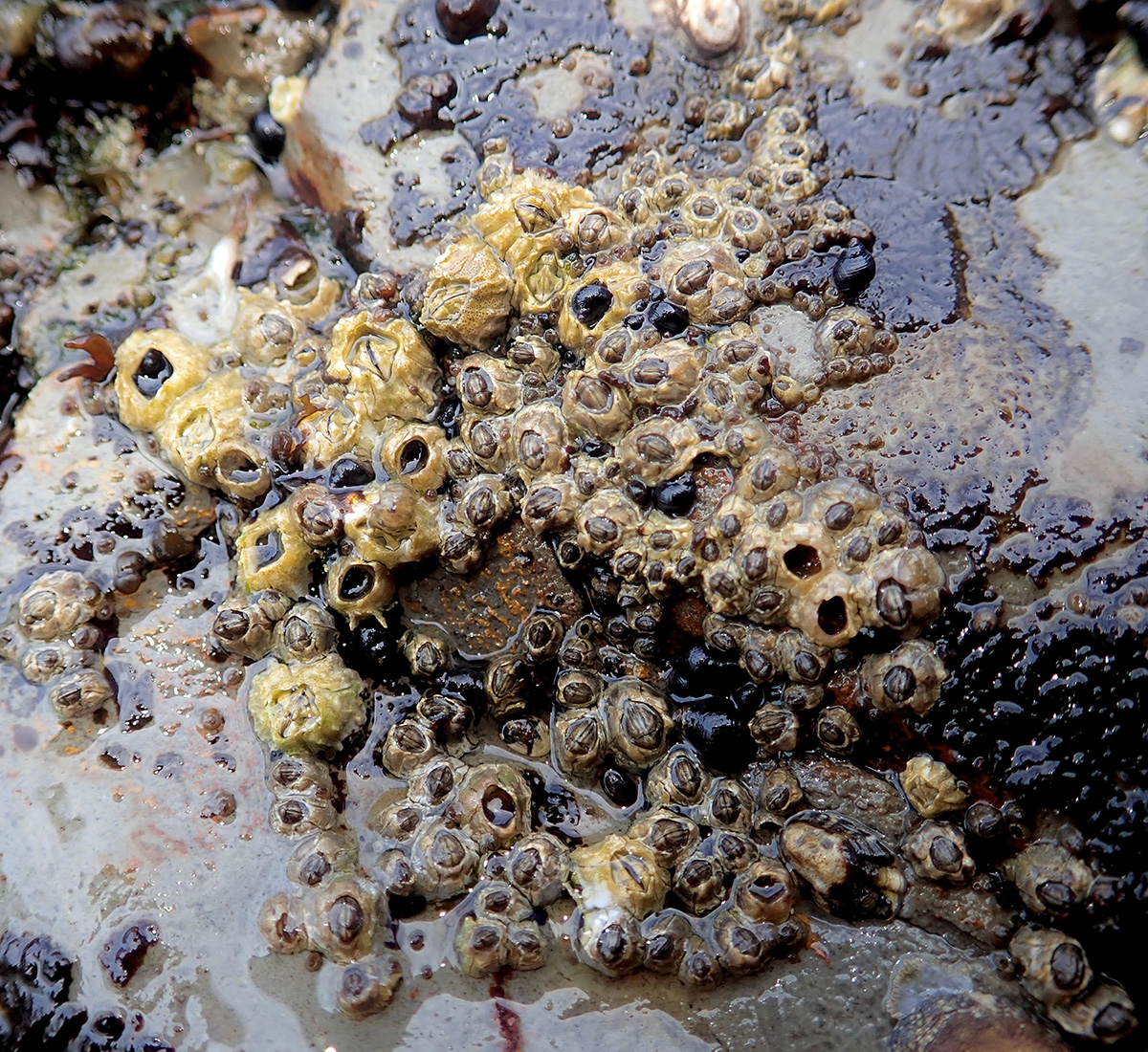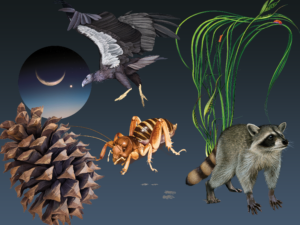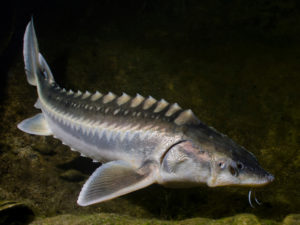We humans are accustomed to thinking of sexual function as being both fixed and segregated into bodies that we designate as either female or male. In the larger animal kingdom sex doesn’t always follow our rules. Many animals are monoecious, or hermaphroditic, having both male and female sex organs in the same body. Not only that, but lots of animals change from one sex to the other. As in so many aspects of biology, the way humans do sex may be thought of by us as “normal,” but it isn’t necessarily the most interesting way.
Take, for example, the slipper shell Crepidula adunca. This is a small limpet-like creature that lives on the shell of a larger snail. Around here the usual host is a turban snail, either Tegula funebralis or T. brunnea.

Sometimes C. adunca is found in stacks. I’ve never seen a stack taller than three individuals, but its Atlantic relative C. fornicata occurs in stacks of up to six. The animal at the bottom of the stack is always the largest, and a given turban snail can play host to more than one stack at a time.

As you might guess, it isn’t mere happenstance that these stacks of C. adunca occur. It turns out that this unusual living arrangement is key to both sexual function and eventual reproduction in this species. The individual on the bottom of the stack — the oldest — is always a female; those at the top of the stack — the youngest — are males. However, every stack begins with a single individual, and the default sex in newly settled C. adunca is male. In fact, all C. adunca begin adult life as males. An experiment conducted at Friday Harbor in Washington State showed the change from male to female began when the snails reached a size of 7 mm, and all animals larger than 10 mm were female.
Crepidula adunca‘s unusual living arrangement also facilitates reproduction. Unlike most limpet-like gastropods, C. adunca isn’t a broadcast spawner. Rather, it copulates, as hinted at by the species epithet of its congener C. fornicata. A female slipper shell with a male on her back has a convenient source of sperm with which to fertilize her eggs; the male reaches into her mantle cavity and transfers sperm to her. Which means a female cannot mate until she carries at least one male on her back, and a male cannot reproduce unless he settles atop a female. Once the eggs have been fertilized, they develop within the mother’s mantle cavity until she pushes them out as little miniatures of herself.

Animals that change sex from male to female, such as Crepidula adunca, can be described as protandrous (from the Greek for “first male”) hermaphrodites. Logic dictates that the switch might also occur in the opposite direction, with an animal beginning reproductive life as a female and shifting entirely to male function; these animals would be described as protogynous (Greek “first female”) hermaphrodites. Some fishes, such as the California sheephead (Semicossyphus pulcher) that live in southern California kelp forests, are protogynous hermaphrodites.
In Northern California tidepools we have a sea anemone (Epiactis prolifera), that exhibits a strange combination of protogynous and simultaneous hermaphroditism. At a young age it has female sexual function, then as it matures it develops testes and functions as both male and female, sometimes even fertilizing its own eggs. This reproductive system is called gynodioecy and results in a population consisting of small females and larger hermaphrodites.

One notable thing about Epiactis prolifera is that whether an individual possesses ovaries only or a combination of ovaries and testes, it is a good mother. This species’ common name “brooding anemone” implies that the anemone hangs onto its young for a certain period of time, and E. prolifera does exactly that. Eggs are fertilized internally, by either the animal’s own sperm or sperm from a neighboring anemone, and larvae live inside the mother’s gastrovascular cavity. At some point the larvae crawl out of the mother’s mouth and settle into small pits on her column, where they metamorphose into tiny anemones. These babies may or may not be clones of their mother. It is not uncommon to see an Epiactis anemone with a 2-centimeter oral disc diameter brooding half a dozen or more juveniles. While residing on their mother’s column the juveniles are protected by her umbrella of stinging tentacles, and once they have grown up a bit they crawl away and begin life on their own.

What about simultaneous hermaphrodites? Those would be animals that have male and female function at the same time, and we have those in our local tidepools, too! The most prominent of these would be the barnacles. Along the Northern California coast we have a handful of barnacle species living in the intertidal. In the higher mid-tidal regions at some sites, small acorn barnacles of the genera Balanus and Chthamalus may be the most abundant and conspicuous animals.

Barnacles have two planktonic larval stages: the nauplius and the cyprid. The nauplius is the first larval stage and hatches out of the egg with three pairs of appendages. Its job is to feed and accumulate energy reserves. It swims around for several days or perhaps a couple of weeks, getting blown about by the currents and feeding on phytoplankton.
After sufficient time feeding, a barnacle nauplius metamorphoses into the second larval stage, the cyprid. A cyprid is a bivalved creature, with the body enclosed between a pair of transparent shells. It has more appendages than the nauplius, and these are more differentiated. If the nauplius has done its job well, then the cyprid also contains a number of oil droplets under its shell. These droplets are of crucial importance, because the cyprid itself does not feed and survives on the calories stored in those oil droplets. The cyprid’s job is to return to the shore and find a suitable place on which to settle. Somehow, a creature about 1 millimeter long, being tossed about by waves crashing onto rocks, has to find a place to live and then stick to it.
One thing that makes a particular site attractive to a cyprid looking for a home is the presence of adults of the same species. The larvae of many marine invertebrates are drawn by the chemical signature of their parents’ generation—indeed, that’s one of the factors resulting in clusters of mussels that you see when you visit the tidepools. However, for barnacles the clumping is necessary not just for safety or mere suitability of habitat. Without immediate proximity to neighbors of their own kind, barnacles cannot reproduce.

Barnacles are simultaneous hermaphrodites, each adult containing mature gonads of both sexes. This is advantageous, in that any barnacle can mate with any other barnacle of its species. That is, with any other barnacle it can reach with its penis. You see, barnacles are crustaceans, and crustaceans have non-flagellated sperm that don’t swim. This means barnacles cannot just spawn and rely on currents to bring sperm and egg together. They must copulate. In other words, sperm must be transferred directly from a barnacle acting as male to another barnacle receiving sperm and thus acting as female, via an intromittent organ, or penis.
Not only that, but barnacles are permanently attached to the site selected by the cyprid when it was looking for a home. This means that a barnacle’s potential mates are limited to the other barnacles it can reach with its penis, and its own eggs can be fertilized only by barnacles whose penises can reach it. As you might expect, this constraint has resulted in strong selection for penis size in barnacles. In fact, barnacles have the longest penises, relative to body length, of any animals! This maximizes a barnacle’s reproductive success by allowing it to transfer sperm to as many neighbors as possible.
Here’s a video clip of Balanus glandula extending its penis along with its thoracic feeding appendages:
Throughout the animal kingdom, sexual reproduction is defined as the union of egg and sperm to create a new, unique genetic entity called a zygote. As we’ve seen, animals accomplish this in a variety of ways. At the level of the gamete, the distinction between male and female function holds for all animals—females produce eggs, and males produce sperm. But at the level of the body, that distinction becomes blurred. Some bodies first produce eggs and then sperm, some do the reverse, and some produce both gametes at the same time. This delightful fluidity of sexual function gives people another reason to appreciate some often overlooked animals. It is not likely that you will see barnacles trying to copulate if you visit the tidepools at low tide. But they will be there, as will the brooding anemones and slipper shells. And when you see them, remember how these little creatures bend some of the rules that we take for granted.




